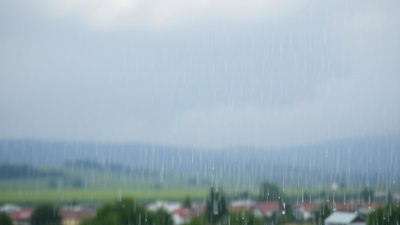What Happens When the Forecast Says Rain but It Stays Dry All Day
Explore the science and factors behind inaccurate weather forecasts.

Weather forecasting is a complex science that involves analyzing vast amounts of data to predict future conditions. The accuracy of these predictions can sometimes fall short, particularly when rain is forecasted but the day turns out to be dry. Understanding why this happens requires a glimpse into the intricate processes of meteorology and the various elements that influence weather patterns.
At its core, weather prediction relies on meteorologists’ ability to interpret atmospheric data collected through satellites, weather stations, and radar systems. This information helps them understand current weather conditions and trends, allowing them to make informed predictions about what might happen in the near future. However, the atmosphere is a dynamic system, and even slight changes can lead to unexpected weather outcomes.
The Role of Atmospheric Conditions
One of the primary reasons rain may be forecasted but does not occur is due to changes in atmospheric conditions. The atmosphere is constantly in flux, with temperatures, pressure systems, and humidity levels shifting rapidly. For example, if a weather system that was expected to bring rain moves more quickly than projected or begins to weaken, it could result in a dry day instead.
Furthermore, the timing and location of these systems play a crucial role. If a cold front that was supposed to generate precipitation moves out of the area or dissipates before reaching a particular region, the forecasted rain may never materialize. Additionally, localized weather phenomena, such as microclimates, can create conditions where rain falls in one area but not in another that is very close by.
Forecasting Limitations
Forecasting is not an exact science; it is often filled with uncertainties. Meteorologists use models that simulate the atmosphere’s behavior based on current data, but these models can only make educated guesses. Forecasts are typically expressed in terms of probabilities, such as an 80% chance of rain, which indicates that models have shown previous instances where similar conditions produced rain. However, there is still a possibility that the predicted outcome will not occur.
Furthermore, advancements in technology have significantly improved forecasting accuracy, yet there are still limitations. Weather models depend on initial conditions; if those initial data are incorrect or incomplete, the model projections can drift away from reality. This is why even the best forecasts sometimes miss the mark.
Human Interpretation
Another element that can lead to discrepancies in forecasting is the human interpretation of the data. Meteorologists analyze model outputs and integrate their own experience and knowledge of regional weather patterns. Sometimes, human error or a variance in judgment may affect how predictions are communicated. For example, a meteorologist might base their forecast on a specific model that suggests rain, while alternative models might indicate different outcomes.
This subjectivity can lead to situations where the forecast calls for rain, but the weather does not cooperate, leaving residents surprised by the dry conditions. Moreover, the communication of forecasts can also vary based on region. Areas accustomed to certain weather patterns may have forecasts framed through that lens, potentially leading to misunderstandings amongst residents.
The Influence of Geography
Geography plays a significant role in local weather behavior and can contribute to missed precipitation predictions. Coastal areas often experience different weather patterns than inland regions due to differences in temperature, humidity, and wind direction. These geographic features can create scenarios where rain is projected to occur due to large systems in the vicinity, but local conditions render the day unexpectedly dry.
Mountains, valleys, and bodies of water also influence weather prediction accuracy. For instance, mountainous regions can block rain-bearing clouds from reaching certain areas, while valleys may be sheltered from these systems altogether. Consequently, places with complex terrains are particularly prone to discrepancies between forecasts and actual weather conditions on the ground.
Analyzing Past Forecasts
Looking back at historical weather data can reveal patterns of inaccurate forecasts. Research shows that there can be trends in certain seasons or geographical areas where rain predictions are more prone to oversight. For example, transition seasons like spring and fall feature unstable atmospheric conditions that can lead to increased forecasting errors. This can be attributed to the changeable nature of weather during these times, when warm and cold air masses frequently collide.
Moreover, localized phenomena, such as thunderstorms, can develop rapidly and may occur in small areas, leading to significant forecasting challenges. Even sophisticated atmospheric models can struggle with predicting such dynamic and localized events, resulting in inaccuracies when rain clouds fail to materialize.
Impacts on Daily Life
The impacts of receiving a rain forecast that ends up dry can significantly affect many aspects of daily life. Farmers rely on accurate weather predictions for irrigation and crop management, while event planners depend on timely forecasts to prepare for outdoor activities. When residents expect rain based on forecasts, they may carry umbrellas or plan indoor activities, only to be surprised by dry skies.
Additionally, businesses that cater to outdoor scenarios, from festivals to construction projects, often make decisions based on rainfall predictions. When forecasts are wrong, it can lead to financial setbacks and logistical challenges. Recognizing the reasons behind these discrepancies is crucial for mitigating risks associated with inaccurate forecasts.
The Role of Technology
Advancements in weather prediction technology aim to reduce inaccuracies. New software and algorithms are being developed that integrate artificial intelligence and machine learning to improve forecasting capabilities. By analyzing vast datasets and learning from past patterns, these technologies may enhance accurate predictions, ultimately reducing the number of days where rain is forecasted but does not occur.
Moreover, the increasing availability of real-time weather data allows meteorologists to adjust forecasts on the fly. This can lead to corrections as conditions evolve, providing the public with more accurate and timely information. In this age of technology, the gap between forecasts and reality can be narrowed, ultimately enhancing preparedness for weather events.
Conclusion
In conclusion, when the forecast predicts rain but the day remains dry, several interrelated factors contribute to this phenomenon. The dynamic nature of the atmosphere, limitations of modeling, human interpretation, geographical influences, and advancements in technology all play pivotal roles in weather prediction inaccuracies. Understanding these elements can help individuals and communities better prepare for unexpected weather outcomes while fostering realistic expectations for the reliability of weather forecasts.











